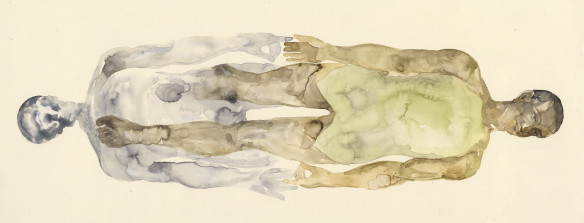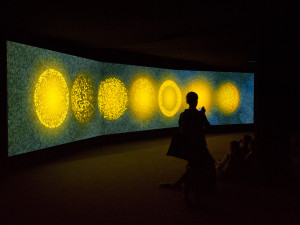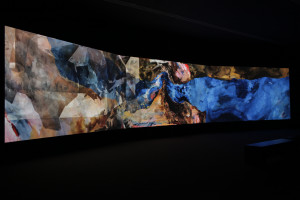Artist Beyond Borders
By Ilona Yousuf | Art | Arts & Culture | Published 10 years ago
At the Lahore Literary Festival (LLF) this year, New York-based Shahzia Sikander received the Artist of the Year Award. Although she has made several trips to Pakistan since the 1990s to meet her family, Sikander has lived and worked primarily in the US. So this trip, which brought recognition of her artistic merit and achievements on home turf, and the seminars at her alma mater the National College of Arts (NCA) and at the Lahore University of Management Sciences that followed, was something of a homecoming.
Our long conversation took place in the writers’ lounge after her presentation, The World in Miniature, at the LLF, which featured a talk with slides showcasing her early work and video clips from her latest animated installation, ‘Parallax,’ first exhibited at the Sharjah Biennial in 2013. While we talked, she periodically extracted images from her laptop to illustrate her development as a modern miniaturist and her experiments with digital animation since 2001. Some questions were left unanswered, however, and since the artist was travelling extensively during March, this article was pieced together through short email exchanges, backed up with images, notes, John Zarobell’s essay on ‘Parallax,’ and my own research from the internet. What was planned as an interview became a profile. A stickler for correct facts and immense detail, she wrote via email “it (the interview)…is always a process that takes some time,” and “we spoke in such an organic manner, I want to be sure that nothing is out of context.”

Sikander’s movements are quick and lithe, her hands and mouth mobile, and her gaze direct when she talks. She talks at length, and willingly, about her work; otherwise there is a guardedness about her, as if she is hesitant to reveal her personal self. But reading the transcript of an interview from 2005 with a group of high school children, on the Museum of Modern Art website, I realise that Sikander must be an inspiring teacher: she is warm and engaging, talking about growing up in Pakistan during the Zia era in the 1980s, the role and response of her family to her chosen career, and what she enjoys doing when she isn’t creating art. But her intense focus and commitment to the latter is always visible. Watching footage of her in the documentary Artist to Artist shown at the Sharjah Biennial, the viewer follows Sikander through the city and in conversation with other artists. One gets the feeling that she is constantly in search of impressions and images, and the desire to understand and make something of them.
As a young girl, she says, “I never thought of being an artist, but drawing came naturally to me. Also, I enjoyed it. It was mostly effortless. I would make portraits of others easily when I was a teenager. Later in life, when I was at the NCA in Lahore, I became interested in art as a thought process.” At a time when deciding to become an artist was an out of the ordinary choice, her family, most of whom were professionals, both men and women, “was supportive…as long as there was good reasoning, one was able to generate the support needed for the issue at hand…I was a hard worker all my life and my family was always more concerned that I worked too hard.” Later, when she went to the US, this family support must have stood her in good stead: “My decisions were always respected in my family and that was a great trade-off. It encouraged me to take risks in my work/life.”

Sikander began her formal artistic career by choosing miniature painting as her major at the NCA, when the form was considered little more than a craft, without any intellectual possibilities. She was one of only two students in the department, headed by Bashir Ahmed, keen to learn because she realised that her professor was a virtuoso in the art of colour-mixing, technique and in the language of miniature painting with its many schools of practitioners. Although Ahmed was less exacting than the traditional masters, the training resembled an apprenticeship. Because there was little interest in the genre at the time and because limited material on miniatures was available, even in museum collections, the emphasis lay on copying the paintings of the old masters. However, during her training, Nazish Attaullah organised a presentation by Robert Skelton, who specialised in the paintings of North India and the Deccan at the Victoria and Albert Museum in London, which was illustrated with over 500 images. It was at this point that the highly individualistic Sikander realised the potential — for her own artistic future — in her chosen field.
Her thesis work, ‘The Scroll’ (1991), contained the seeds of her future experiments with modernising the form. A long, narrow piece, almost 68 inches wide, it defied the convention of the miniature, which was traditionally used to illustrate books or albums. But this was not the only intervention. The work was divided into sections depicting scenes from domestic life, creating a personal narrative. The sections themselves broke out of the decorative borders used to frame miniatures, interrupted by, for instance, the roofs of houses, a device from the Kangra School of painting; while the red fence that ran along the top of the painting was from the Safavid tradition, used here abstractly to denote a line of demarcation. “The Scroll depicts a day in a life — the picture plane is not static — that’s why the vertical ends are open,” she says. “I was looking at film at that time — miniature painting has a static element, and I wanted to inject a non-static element/idea into it…”

At a time when miniature painting had yet to achieve the recognition that it commands today, Sikander was lauded for her approach and technique by Salima Hashmi, who reviewed her thesis and also curated her first exhibition. She effectively paved the way for a generation of modern miniaturists, who are now well known artists in Pakistan and internationally.
Returning to the NCA in 1992 to work with Bashir Ahmed after her graduation, Sikander became the first woman to teach miniature painting in the history of the department; a major shift, as Ahmed had been teaching since 1976. She left for the US a year later to present her work at the Pakistan Embassy in Washington DC. The one-day show of 40 paintings yielded no sales, but the artist decided to show her work to various art schools anyway. The Rhode Island School of Design provided her with financial assistance for a Master’s degree, which she completed there. The intellectual freedom that came with this move to the US — she had found the atmosphere in her home country oppressive — enabled her to explore ideas that had interested her from her days at the NCA; “I was less invested in just making a drawing and more invested in making a proposition through the drawing,” she says. Now, the questions that occupied her mind were: “How do you give form to a thought? How do you connect your thoughts? How do you make something personal without making a portrait? How do you illustrate ambiguity? Eva Hesse took the language of her art and put a different spin on it, without aggressively announcing herself or her gender.”
The challenges of her early years as a young artist growing up in an oppressive political atmosphere had led her even then to incorporate elements from Hindu mythology, such as the Gopi-like hair of female Krishna devotees, into her paintings, as if to remind people of the cultural overlaps that existed before Partition, but had been methodically erased from cultural memory — and to challenge the status quo. This element has been used repeatedly over the years, often in a humorous way, and has become synonymous with the idea of transformation which permeates her animated works, such as ‘SpiNN,’ ‘The Last Post,’ ‘Pivot’ and most recently ‘Parallax.’
 The idea of using animation began at a residency at Artpace in San Antonio, Texas, in 2001. While making a painting using her usual technique involving multiple layering, the artist decided to “record the process by scanning each stage of development and then creating an animation out of the various stages.” (John Zarobell, Five Views of Shahzia Sikander’s Parallax). This animation was exhibited along with the completed painting, titled ‘Intimacy.’ The experiment proved to be a departure point for Sikander. Over the years since, with the help of more advanced technology, she has refined the process to create high-definition works, the animation for which is a single-channel image projected onto three screens. These installations now include collaborations with poets and composers, like the performance artist, Du Yun.
The idea of using animation began at a residency at Artpace in San Antonio, Texas, in 2001. While making a painting using her usual technique involving multiple layering, the artist decided to “record the process by scanning each stage of development and then creating an animation out of the various stages.” (John Zarobell, Five Views of Shahzia Sikander’s Parallax). This animation was exhibited along with the completed painting, titled ‘Intimacy.’ The experiment proved to be a departure point for Sikander. Over the years since, with the help of more advanced technology, she has refined the process to create high-definition works, the animation for which is a single-channel image projected onto three screens. These installations now include collaborations with poets and composers, like the performance artist, Du Yun.
So how does the way that she works today relate to her early training as a miniaturist? For one, the idea of layering is central to traditional miniature painting as it is to her own modern interpretation. Where artists trained in the miniature glued thin sheets of paper to create a surface on which to paint, burnished it and then built up layers of paint using the finest of brushes, her own work embodies layered images expressing multiple ideas. The work process is intensive and time-consuming, much as the creation of a traditional miniature painting would be.
The animations are composed of myriads of drawings, which may be “full drawings, notebook pages, or details. Then they are structured; the work is scaled in different dimensions. From this, [evolves] a narrative, a transformation of form/material/content/space…” shares Sikander. Projects like these, with their hundreds of drawings alone, are time-consuming, while collaborations are even more so. ‘Parallax’ took a year to complete. But the digital age has opened new horizons; without today’s technological advances, creating, organising and synchronising ‘Parallax,’ with its multi-disciplinary character in which visual art, music and poetry recited by the poets themselves are seamlessly woven together, are made possible.
Sikander’s work, including previous video animations like ‘Pursuit Curve,’ is not without a scientific or mathematical dimension. This interest stems from her youth, “I was always interested in math. I was fairly good at it and equated it with problem-solving. I appreciate logic, and studied geometry and trigonometry.”
The definition of ‘Parallax’ is ‘a displacement or difference in the apparent position of an object viewed along two different lines of sight, and is measured by the angle or semi-angle of inclination between those two lines.’ The artist uses the installation to explore Sharjah’s position in maritime trade, the discovery of oil, resultant patterns of migration, and ideas of power and control. Once more, the silhouettes of Gopi-like hair appear, this time massed together but fluid, transforming from one shape to another: flocks of birds, patterns of migration, and, finally, spheres. Within this serious work, as in the past, there are elements of humour. The ‘Christmas trees’ used in locating and extracting oil, which barely resemble their namesake, are drawn in the characteristic triangular shape of the Christmas trees one sees on greeting cards, in red, white and blue: the sly reference to imperial power are obvious.
 In a globalised world, through platforms like art biennials and independent foundations and institutions, Sikander aspires to challenge the labels that might otherwise limit artists. She views these platforms, which aid artists through funding and technological assistance, as a way of challenging local politics and contexts. She rejects the idea of diaspora, for instance, in favour of “transnational,” because borders, despite previous mass migrations, are far more porous than ever before. Throughout her extensive teaching career, she has encouraged young artists to express, not impress. In her own oeuvre, she uses the tools of the digital age to create her own space and provoke her viewers into consciousness, dispelling — destabilising — accepted notions of identity and culture, and affirming the idea of flux.
In a globalised world, through platforms like art biennials and independent foundations and institutions, Sikander aspires to challenge the labels that might otherwise limit artists. She views these platforms, which aid artists through funding and technological assistance, as a way of challenging local politics and contexts. She rejects the idea of diaspora, for instance, in favour of “transnational,” because borders, despite previous mass migrations, are far more porous than ever before. Throughout her extensive teaching career, she has encouraged young artists to express, not impress. In her own oeuvre, she uses the tools of the digital age to create her own space and provoke her viewers into consciousness, dispelling — destabilising — accepted notions of identity and culture, and affirming the idea of flux.
Although Sikander has remained outside the Pakistani art community, physically as well as in academic discourse, she is always mindful of her roots, which are reflected in her work throughout her career. Sikander’s return this year marked the beginning of a project in collaboration with Project Row Houses. The latter is an international organisation, but “this project is to take place in Pakistan and will come into existence through working with many local Pakistanis in various professions, including teachers, artists, theatre artists, musicians, historians etc. Since the project research phase is yet to start, it is hard for me to give more specific details.”
This interview was originally published in Newsline’s June 2014 issue.


